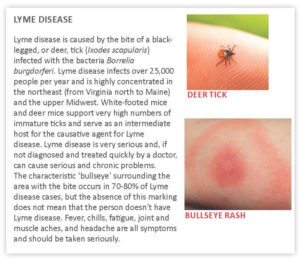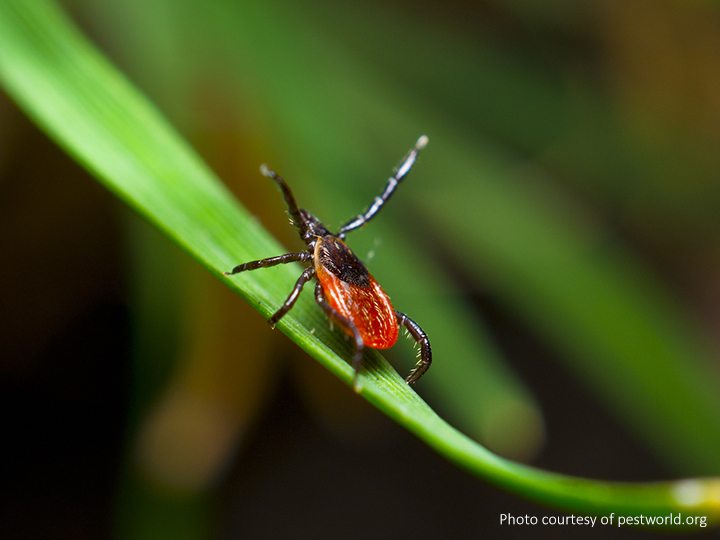Ticks present the greatest public health threat to humans of all pests found in the United States. These small blood-feeders can transmit several disease-causing pathogens across the US including Lyme Disease, Rocky Mountain spotted fever, Powassan virus, and heartland virus. It is important to understand tick biology and behavior to understand options to manage and control ticks.
Tick Facts
- Male and female blacklegged tick larvae, nymphs, and adults all must feed on blood. Nymphs and adults may carry the bacteria that causes Lyme disease.
- Each life stage generally feeds on a larger host than the preceding stages, but this is not always true. Rodents, small mammals, deer, dogs, and humans are preferred hosts and can be fed upon by larvae, nymphs, and adults.
- Ticks locate hosts by questing. Questing ticks climb up grasses and other plants and wait for a potential host to brush past them. Questing often takes place where two zones or features meet, like between a mowed and unmowed area or between a field and forest.
- Adult females can lay 3,000+ eggs. The complete life cycle, from egg to egg, can take 2-4 years.
- Harsh winters can knock tick populations down, but this year has supported very high tick populations, especially in the northeast. The last two winters have been mild and tick populations have not been affected like they usually are.
Tick Management
Tick management is a complex mixture of habitat modification, wildlife management, personal protection, and pesticide application. All of these can provide some measure of relief, but there is not a 100% effective solution, realistically, to prevent tick encounters in an environment that supports them.
Managing ticks over a large area is especially difficult; it requires host reduction and habitat modification above all else. However, depending on your surroundings, you may not be able to make significant changes to the area to combat ticks. Wildlife travel, even in areas where you wouldn’t suspect, and can move ticks with them. Rodents and small mammals can live in hard-to-access places and may not be easily, or legally, managed. Any of these animals can be supporting and spreading ticks.
Pesticide sprays can play a role in reducing tick populations, but there are a couple of factors that limit effectiveness. Ticks are not especially mobile and spend the time they aren’t on a host or questing in protected places, so treating an area may not actually reach them. Applications to grass and shrubs may also not be effective for more than a few days to weeks depending on rain and sun exposure. In areas with consistent human presence, pesticide applications may also be limited. An unconventional pesticide application involves the installation of small stations that appeal to small rodents. The rodents enter and get treated with a pesticide. When a tick feeds on a treated mouse, it will die. This approach is costly but may, over time, lead to a reduction in the local tick populations.
What Can You do to Combat Ticks?
- Keep grass mowed very short and remove leaf litter. This makes it harder for ticks to find a host.
- Trim bushes and vegetation (sunny areas are less hospitable to ticks, so removing shady areas may help).
- Clear debris and other potential animal harborages.
- Make a three-foot barrier of wood chips or gravel between your mowed grass or recreation areas and any wooded areas or places with tall grass that you can’t mow.
- Consider keeping children inside or in a more confined and well-kept area, at least during times with known tick activity. Young children move slowly and spend time playing at or near ground level, making them an easy host for a tick.
- Educate yourself and employees about personal protection. The CDC and EPA have excellent resources for learning about which tick repellents are appropriate.

